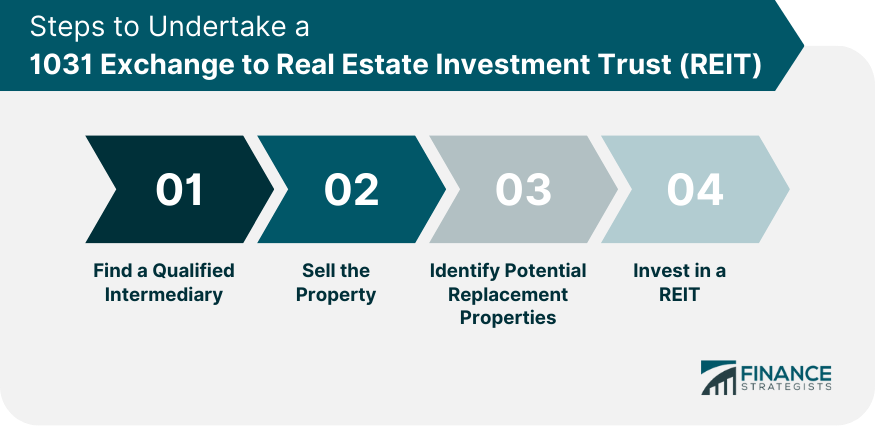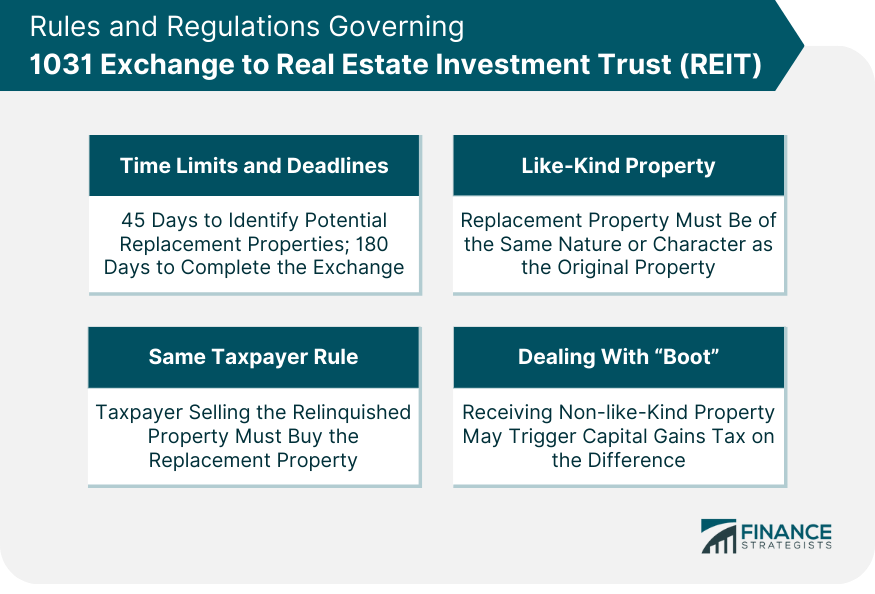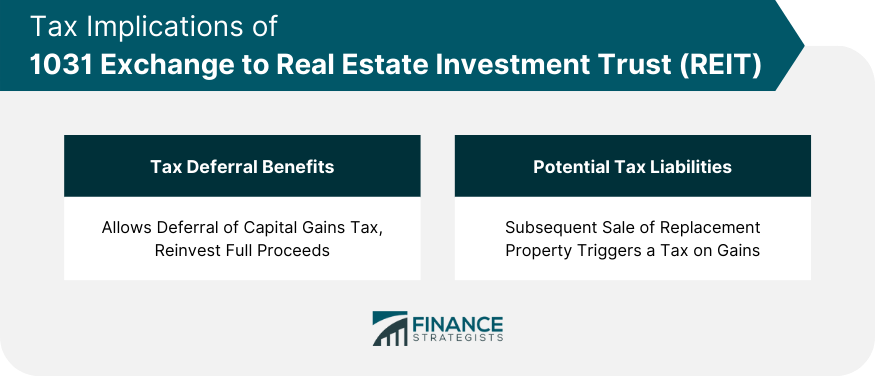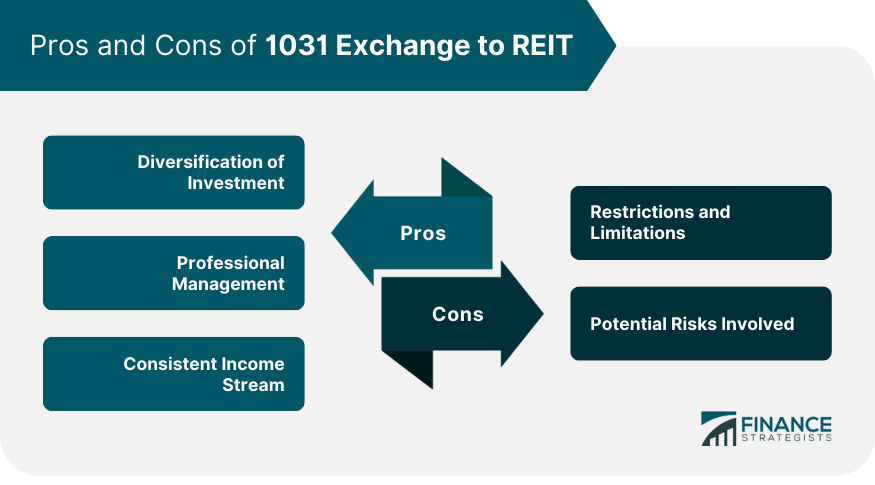In a 1031 Exchange, an investor can sell a property and reinvest the proceeds in a new property and defer all capital gain taxes. IRS Section 1031 states that "No gain or loss shall be recognized on the exchange of real property held for productive use in a trade or business or for investment." The transaction is treated as an exchange rather than a simple sale. Real Estate Investment Trusts (REITs) operate by pooling the capital of numerous investors. This makes it possible for individual investors to earn dividends from real estate investments without having to buy, manage, or finance any properties themselves. A Qualified Intermediary (QI), also known as an exchange facilitator, is an essential part of any 1031 exchange. They are responsible for holding the proceeds of the sale of the relinquished property and for purchasing the replacement property. Selling the property is the first active step in the 1031 Exchange process. It involves marketing the property, accepting an offer, and then closing the sale. The proceeds from the sale are then transferred to the QI. Once the original property is sold, the property owner has 45 days to identify up to three potential replacement properties. The QI will hold the funds until the exchange is ready to be made. If a REIT has been chosen as a replacement property, an interest in the REIT is purchased using the exchange funds. This completes the exchange process and allows the investor to potentially defer recognizing any capital gain from the sale of the first property. There are two key time limits that must be adhered to in a 1031 exchange. The first is that the investor has 45 days from the date of the sale of the original property to identify potential replacement properties. The second is that the purchase of the replacement property and completion of the exchange must occur within 180 days of the original sale. Like-kind property is a very broad term that means that both the original and replacement properties must be of "the same nature or character, even if they differ in grade or quality." In other words, you can't exchange farming equipment for an apartment building because they're not the same kind of asset. The same taxpayer who sells the relinquished property must buy the replacement property. If the names on the titles of the two properties aren't the same, there could be tax consequences. Boot is an old English term meaning "something given in addition." If you receive money or other non-like-kind property in exchange, you may have to recognize this as income and pay capital gains tax on it. The primary benefit of a 1031 exchange is the deferral of capital gains tax. This means that the investor can reinvest the full amount of the proceeds from the sale of the original property rather than having to pay up to 20% in federal capital gains tax. While 1031 exchanges can provide significant tax benefits, they aren't a total avoidance of taxes. If the replacement property is later sold (and not as part of another 1031 exchange), the original deferred gain, plus any additional gain realized since the purchase of the replacement property, is subject to tax. When you use a 1031 exchange to invest in a REIT, you get the benefit of investing in a diverse portfolio of real estate properties. This can significantly mitigate the risk associated with investing in a single property. REITs are managed by professionals who handle all the tasks related to property investment, including property selection, maintenance, tenants, and legal issues. This management expertise is especially beneficial for investors who lack the time or experience to manage properties themselves. REITs are required by law to distribute at least 90% of their taxable income to shareholders annually in the form of dividends, providing a consistent income stream for investors. One limitation of investing in a REIT is the lack of control. Unlike owning property directly, owning a share of a REIT means you have no say over what properties are bought or sold or how the REIT is managed. Like all investments, REITs carry some risk. REIT shares can fluctuate in value, and there's always the possibility of poor management or a downturn in the real estate market. A 1031 Exchange allows investors to defer capital gains tax by reinvesting proceeds from a sold property into a new one, with real estate investment trusts being a viable option. REITs offer benefits, including diversification, liquidity, and professional management, alongside a consistent income stream via required annual dividends. However, investing in a REIT involves certain limitations, such as a lack of direct control over properties and potential market risks. The exchange process necessitates a Qualified Intermediary and adhering to strict timelines and regulations. While a 1031 Exchange can significantly defer tax liabilities, the eventual sale of the replacement property can lead to taxes on the original deferred gain and additional realized gain. Careful planning and understanding of the process are crucial to maximize the benefits of a 1031 Exchange into a REIT.Understanding the Concept of a 1031 Exchange to REIT
How Does a 1031 Exchange Work?
Role and Operation of a REIT
Steps to Undertake a 1031 Exchange to REIT
Find a Qualified Intermediary
Sell the Property
Identify Potential Replacement Properties
Invest in a REIT

Rules and Regulations Governing 1031 Exchange to REIT
Time Limits and Deadlines
Like-Kind Property
Same Taxpayer Rule
Dealing With “Boot” (Non-like-Kind Property)

Tax Implications of 1031 Exchange to REIT
Tax Deferral Benefits
Potential Tax Liabilities

Pros and Cons of 1031 Exchange to REIT
Pros
Diversification of Investment
Professional Management
Consistent Income Stream
Cons
Restrictions and Limitations
Potential Risks Involved

Bottom Line
1031 Exchange to REIT FAQs
A Qualified Intermediary (QI), also known as an exchange facilitator, is a necessary participant in a 1031 exchange. The QI holds the proceeds from the sale of the original property and uses them to purchase the replacement property, ensuring the transaction complies with 1031 regulations.
When you invest in a REIT, you are essentially investing in a portfolio of different real estate properties. This helps to spread risk as the performance of your investment is not tied to a single property.
'Boot' refers to any additional non-like-kind property or money received in a 1031 exchange. If you receive 'boot,' you may have to recognize this as income and pay capital gains tax on it.
No, one of the trade-offs of investing in a REIT is that you don't have direct control over the properties within the REIT's portfolio. The management and decisions regarding the properties are handled by the REIT's management team.
Yes, if you decide to sell your replacement property in a REIT and not reinvest in another like-kind property, the original deferred gain, plus any additional gain realized since the purchase of the replacement property, is subject to tax.
True Tamplin is a published author, public speaker, CEO of UpDigital, and founder of Finance Strategists.
True is a Certified Educator in Personal Finance (CEPF®), author of The Handy Financial Ratios Guide, a member of the Society for Advancing Business Editing and Writing, contributes to his financial education site, Finance Strategists, and has spoken to various financial communities such as the CFA Institute, as well as university students like his Alma mater, Biola University, where he received a bachelor of science in business and data analytics.
To learn more about True, visit his personal website or view his author profiles on Amazon, Nasdaq and Forbes.















